| |||||||
| Search Forums |
| Advanced Search |
| Go to Page... |
 |
| Search this Thread |  8,147 views |
| | #1 |
| Distinguished - BHPian  | Touring the 1961 General Cargo ship - Cap San Diego, Hamburg, Germany First weekend in May the harbour days in Hamburg are held. It is probably one of the largest harbour festivals in the world, certainly the largest in Europe. Hundreds of ships gather for three days in Hamburg. From German Frigates, to Dutch Tugboats, vintage windjammers and so on. All the ships are open, free of charge, to the public. Along the waterfront is a 6 kilometer long fair, with rides and endless food and drink stalls. I had always wanted to visit these harbour days and I also wanted to go on a tour with one of the museum ships, based in Hamburg, The Cap San Diego. So on Saturday morning, very early, around 04.30AM I pointed my W123 Mercedes star east and put the hammer down! Well, this is a 40 year old car, so I keep it at a steady 110 km/h on the cruise control.  Almost 500 kilometers to get to my hotel in Hamburg. I reached my hotel, next to the central station around 10.30. Checked in, parked the W123 in their protected car park and headed out for the harbour. Look at this ship? Isnít she a beauty??  Before we start the tour a little more information on this magnificent general cargo ship. From various internet sources and the (German) brochure from the museum MS Cap San Diego is a general cargo ship, situated as a museum ship in Hamburg, Germany. Notable for her elegant silhouette, she was the last of a series of six ships known as the White Swans of the South Atlantic, and marked the apex of German-built general cargo ships before the advent of the container ship and the decline of Germany's heavy industry. Next to (general) cargo she also carried a small amount of passengers. The Cap San Diego was built and launched by Deutsche Werft in 1961 for Hamburg SŁd as the last of a series of six ships. The 159 m, 10000 dwt ship ran a regular schedule between Germany and South America, completing 120 round trips until 1981. After being sold and running under different names and under Spanish flag and also flags of convenience as a tramp trader, the run-down ship was scheduled for scrapping in 1986 when she was bought by the city of Hamburg. The ship was restored mainly by the labour of enthusiasts and laid-off dock workers, and is kept operational to date. Most of the time, the Cap San Diego is moored at the port of Hamburg where visitors can access virtually all areas of the ship from the bridge to the engine. One of the cargo holds hosts temporary exhibitions. Passenger cabins can be booked for overnight stays. Several times a year, the ship leaves the harbour on her own power for trips mostly on the river Elbe or to Cuxhaven. In 2001, the ship was awarded the Maritime Heritage Award by the World Ship Trust, and in 2003 she was declared a protected item of cultural heritage under Hamburg law. She is powered by a MAN K9Z 140 D two stroke crosshead engine, has nine cilinders and three turbo chargers. The engine produces 11650 horsepower at 118 revolutions per minute. Giving her a top speed of well over 20 knots (about 38 kilometers an hour). She is very similar to the first ship I ever sailed on, as an apprentice engineer as part of my training; The Nedlloyd Florida. Same size, same engine power, same cargo hold configuration, age etc. So this really brings back many memories. Just a photograph of the brochure will show you some of the details. Unfortunately, all in German. Ze Germans are still a little behind by providing their brochures, or website for that matter, in English.  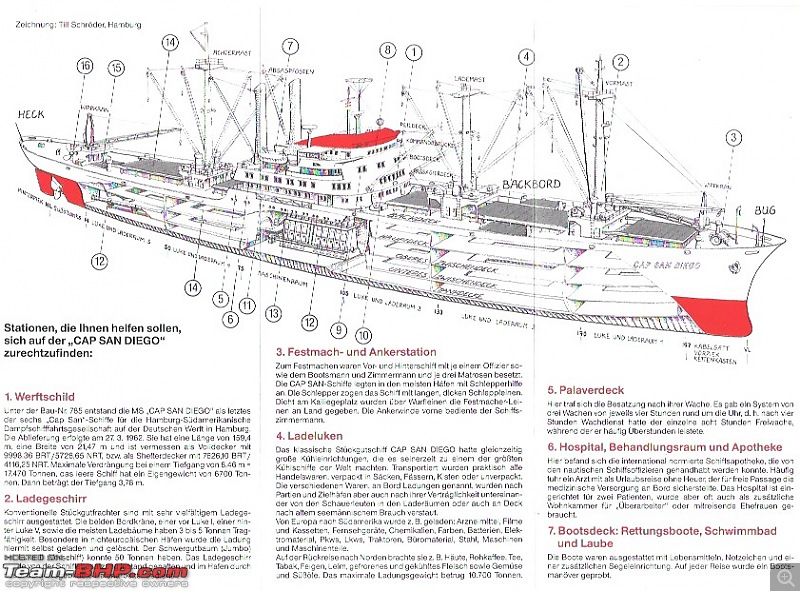 I had booked this trip many months ago and had been really looking forward to it. I spend three days in Hamburg, but the highlight of my stay was definitely sailing and touring on the Cap San Diego. As you would expect from a former Merchant Navy Chief Engineer and nerdy techy, I will focus heavily on various technical parts of the ship. We were allowed on the ship around 12.00am with sailing scheduled for 13.00pm. First thing I did was head for the engine room, obviously!!  On most of these sort of ships you enter the engine room from above. There is a little platform above the main engine. It gives you a good view of the top of the engine. You are looking at the forward four cilinder heads and two of the turbo chargers. Those huge pipes going into the center of the cilinderhead are the fuel lines going to the injectors.  Here we are facing aft, on the cilinder head deck. Notice the size of this engine and its component in relation to the engineer!  Just to get your perspective on the size of this main engine. Here a little drawing that will visualise it, I hope 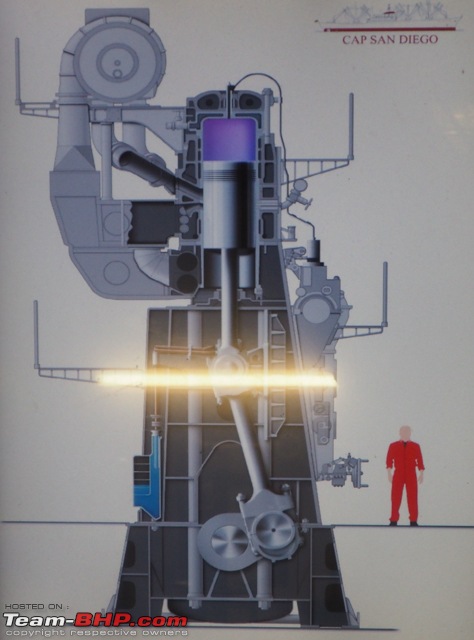 This engine has a height of almost 10 meters, a length of almost 16 meters and is 4 meters wide. It weighs more than 500 tonnes!!! So this is a BIG engine even by today standards. Not as big as modern ships two stroke diesels, but never the less, still very impressive. Lets look at some details. Here a close up of one of the turbo chargers  Here you see, what sits inside the turbo charger. It is one shaft with on the left a Jet turbine wheel on which the exhaust gasses are directed. On the other (right hand) end of the shaft a compressor wheel to compress inlet air for the engine. 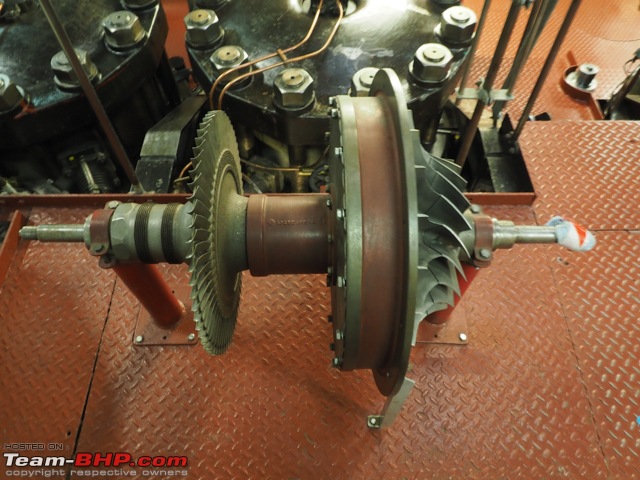 Ships carry spares of everything. And they are bolted down all over the engine room. Here one of the cilinder liners. You can see the scavenging air ports in the side of the liner. This is a two stroke diesel with only scavenging ports. The engine on the NedLloyd Florida has inlet ports and outlet valves. Having outlet valves instead of outlet ports allows for better air flow (scavenging) of the cilinder. A cilinder liner like this easily weighs several tonnes. During my career I have pulled several of these for maintenance and for repair. We had to do this once, in the middle of the ocean, with pretty heavy seas. Not an easy job, with such a huge lump of heavy metal swinging from the crane!  Each cilinder has its own cilinder head. Here you see it, with its lifting frame attached.  Here you see some other spare parts. Well, these would not be used as spares, the are cut-away parts to show the guests how they work. The bit in the front is a fuel injector and behind it are some, I believe, air starter valves. They would carry a large number of fuel injectors and parts to overhaul each injector too. We would carry several sets. Overhauling an individual injector could easily take several hours. So you would pull the old injector, put a new one in and overhaul the old one later.  Letís explore this huge engine some more. Just underneath the cilinder head deck you will find on the port side the high fuel pressure pumps. 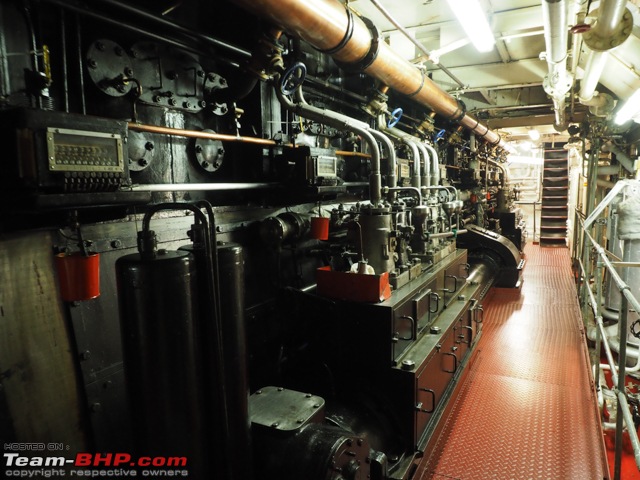  Also, the cilinder lubricators are positioned along the engine here. Each cilinder liner has a dedicated lubrication device. It was the responsibility of the duty engineer to check they were working correctly. If not, you would very quickly have some major problems. I know, I once had to fly out from home on quick notice to go a fix and engine that had run without cilinder lubrication. We had to replace all pistons and all liners! It is driven by a crank mechanism on the right. On the left is manual crank. Prior to the first start of the engine, the engineer and or oilers would give it a number of terms. This would ensure the cilinder liner would have some lubrication oil on its first start too.  This is the manoeuvring position. These ships had manned engine rooms. The bridge would give signals to the engine room staff by means of a so called telegraph. The engineer on duty would acknowledge the signal and start/run the engine accordingly. These large two stroke engines are couple directly to the propellor. They can turn two ways. So to go from ahead to astern of vice verse, the engine had to be stopped and started in the other direction. All done with these handwheels you see here. Usually the telegraph and the engine controls had some sort of interlocking mechanism. Just to prevent starting in the incorrect direction. During manoeuvring there would be a number of staff in the engine room. The chief engineer and at least one duty engineer. There would be several oilers walking around too. Usually one of them would be dedicated to keep the air pressure vessels full. These engines start by means of compressed air. So there are a couple of massive compressors to fill two huge pressure vessels up to 30 bars. No automation, you have to keep an eye on the pressure gauge and switch the compressors on/off by hand. Drain condensate etc.  Main engine control and alarm panel 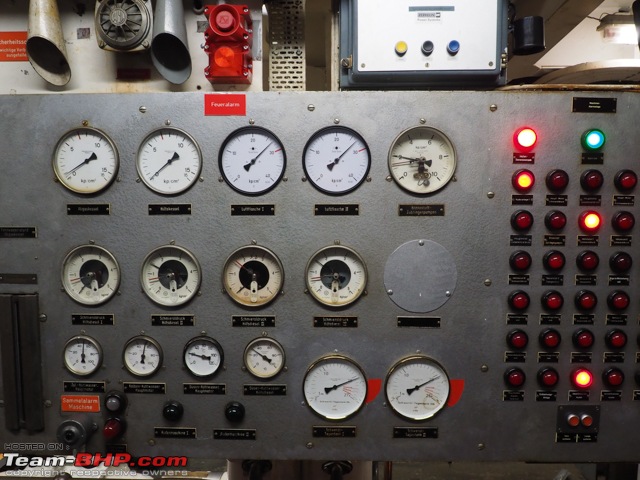 Most engine rooms are kept clean. I mean meticulously clean. But the Cap San Diego engine room gave new meaning to a clean engine room. I spend several hours in the engine room and I did not have a spot of oil on me. Not even on my hands, that keep touching the various hand rails as you go up and down endless stairs. Look at this!!! Somebody has put a lot of elbow grease into getting it to look like this!! 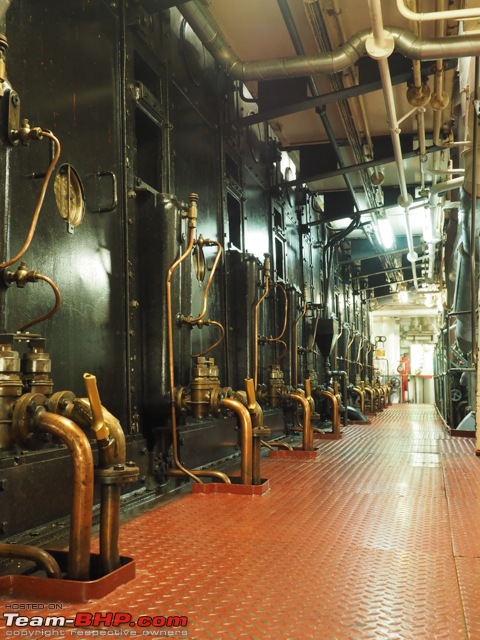 The business end of the engine. This is the propellor shaft and the, what else, so called propellor tunnel. The shaft is connected directly to the engine and the propellor. It runs, very smoothly in a number of bearings.  Apart from the main engine, an engine room is always full of all kinds of machinery and endless pipes, valves, filters and all kinds of technical stuff. Valves and often pipe flanges are painted in different colour, so they can be easily identified. E.g. green means seawater, blue means fresh water, yellow means lubrication etc etc. 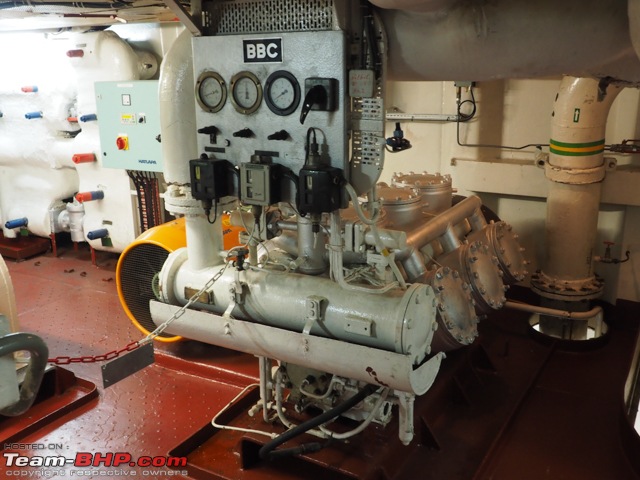   Next to the Main Engine, she also has four auxiliary engines. These are Deutz V8M 536, 500 Horsepower, 514RPM. They each drive a 310 KW generator that provides 440V/60Hz. 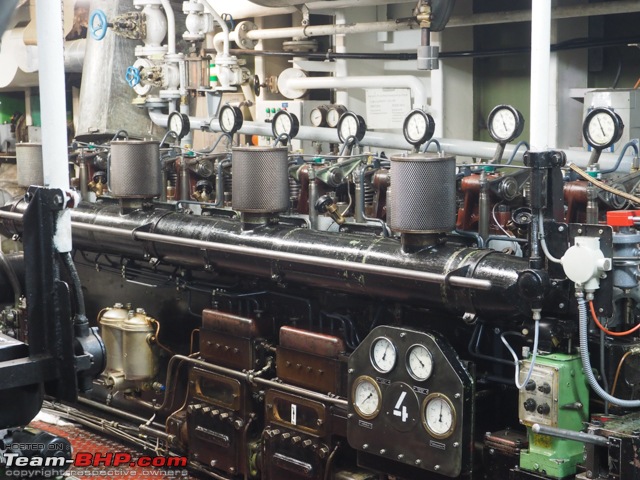 They had an interesting piston from one of its aux engines on display. It says (In German) this piston has run too long!! 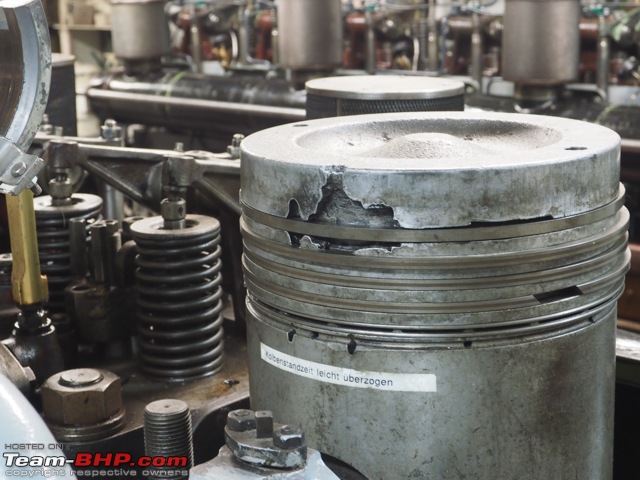 And of course various electrical panels. Most vessel have a three phase, 440V, 60Hz system. Other power requirements (such as 220V/50 Hz) are derived from this. The reason is partly historical. When you start with 440Hz/60Hz, it is also easy to use 380V. At 60Hz electrical motors can run at higher RPM, (relatively). 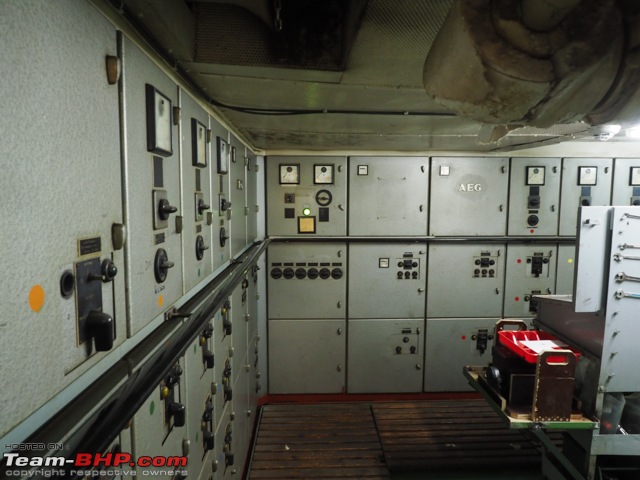  Most of these sort of vessels, will have a boiler for various purposes. That could be a basic as to provide heating to the cabins, or to heat (heavy) fuel, or cargo (more later). The Cap San Diego had a pretty decent boiler in the engine room. 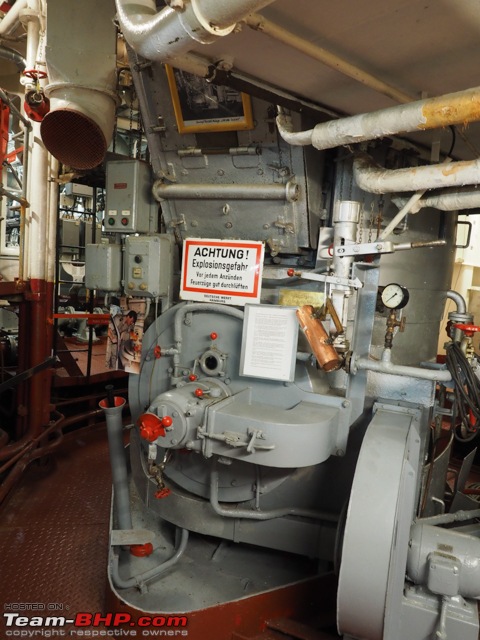 Last edited by Jeroen : 9th May 2023 at 15:34. |
| |  (36)
Thanks (36)
Thanks
 |
| The following 36 BHPians Thank Jeroen for this useful post: | anivy, Aquitej, ashpalio, BlackBeard, Clown Prince, corvus corax, denzdm, DiMaGo, dragracer567, furyrider, gomzi, GTO, GutsyGibbon, JediKnight, libranof1987, Old_Salt, pacman2881, PGNarain, PM - B, ransomware, raptor_diwan, Reinhard, ryzen7@5800u, Samfromindia, sanjayrozario, sarathlal, shashanka, shipnil, SlowRider, Thad E Ginathom, V.Narayan, v12, Venkat_KM, vigsom, Voodooblaster, ysjoy |
| |
| | #2 |
| Distinguished - BHPian  | Re: Touring the 1961 General Cargo ship Cap San Diego, Hamburg, Germany Some more machinery. These are various lubrication oil filter systems.  This particular machine brought back some memories. It is an evaporator, fresh water maker! A vacuum is created (usually with water ejectors) inside the dome which is filled with seawater. The (fresh) cooling water from the main engine is piped through it. Your typical cooling water temperature would be around 70 degrees or so. Due to the vacuum, i.e. low pressure the sea water will boil, the vapour is then captured and condensed, et voila, fresh water!! Works really well, but it has a few issues. You can only use the system out on a big sea/ocean. Well away from the shores and rivers deltas. Because you are converting it into fresh water used for cleaning, cooking etc. Usually, some water treatment was done as well, but in those days we had very little onboard. And the oceans were a hell of a lot cleaner as well. I don’t if these sort of evaporators are still used on modern ships? I know on yachts we use very effective filtration/membrane systems. The other thing is of course, as the water boils off, the salt is left behind. Cleaning these evaporators on the inside is a huge PITA.  This is the separator room. Apart from the boiler room, often the hottest place in the engine room. Seperators are used to clean fuel and lubrication oil. They are able to separate contaminants and water out of fuel and lub oil. 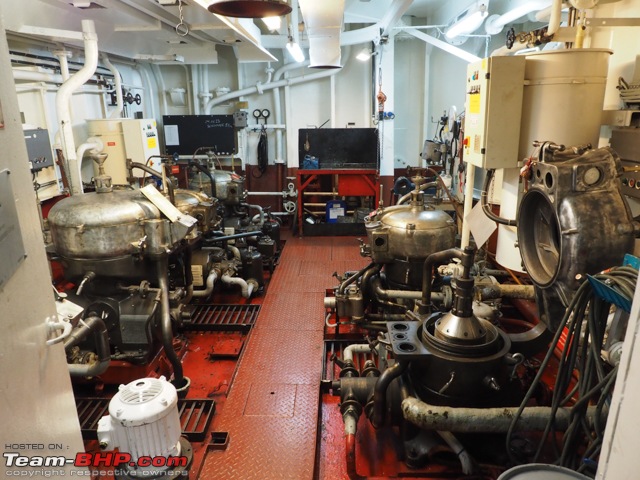 A close up of the separator, essential a centrifuge with a lot of different blades stacked on top of each other. The heavier components get thrown to the outside of the seperator. Very messy job cleaning these. Especially if you are running heavy fuels through them.  A final shot of some of the engineers and guests on the manoeuvring stand.  I have put together a small video, taken at different places in the engine room whilst under way. We are doing about 7-8 knots here, so real slow. Depending on where you are you will hear very different sounds. Crank up the volume, put on some ear protectors, stuff some oily rags in your pockets and have a look/listen: The Steering gear room on the afterdeck was also open. So here you see the hydraulic steering gear. Not much to see, but trust me, it is a clever system.  Lets have a look around the ship some more. Cap San Diego was equipped to carry some 20 passengers as well. Obviously, it therefor needed a “grand’ staircase”. 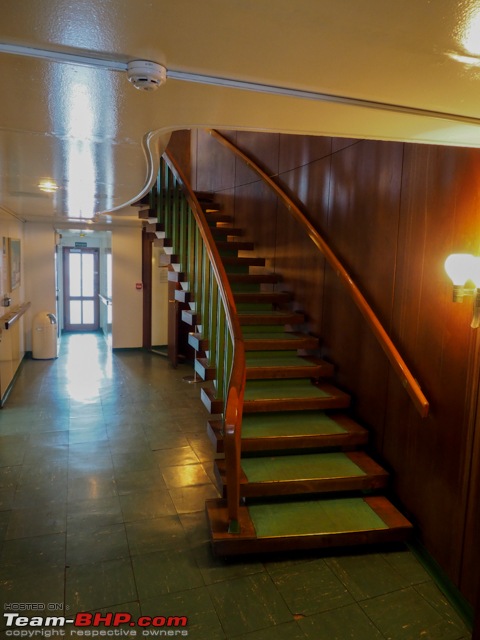 The staircase let up to the salon for the passengers and their accompanying mess room. We had a similar arrangement on the Nedlloyd Florida. The passengers ate with the officers.  Climb up some more chairs and you find yourself going onto the bridge via the chart room.  The bridge of most modern ships would even impress Captain Kirk of the starship Enterprise. The bridge of a general cargo liner from the 60s is a pretty simple affair, in comparison. 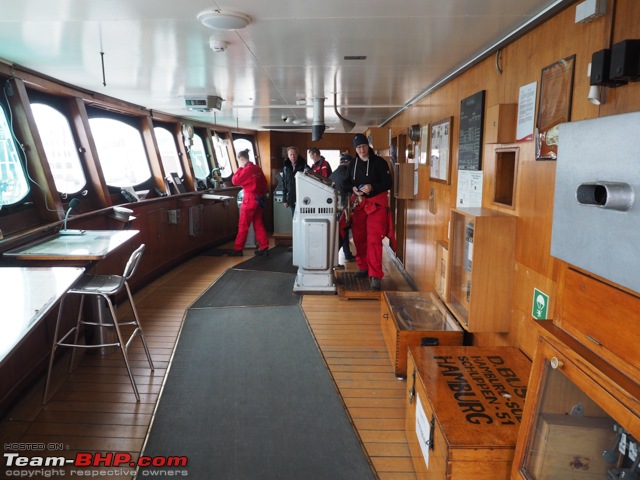 Also, on the bridge, the CO2 fire suppression system. In these days ships were equipped with a huge set of CO2 bottles. In case of fire, in a hold or engine room, the alarm would be sound, everybody had to make their way out, they would close the respective water tight doors and hatches and then pull the respective CO2 handle.  It was a very effective system, but also very dangerous. If anybody was left behind, you would die. Also, you had to put breathing apparatus on to go back in. I know, because I had to do it once. We had a engine room fire, we evacuated the engine room, did everything by the book, pulled the CO2 to find out the third engineer had gone back in. Me and another engineer went back in to find the guy but he had passed away already. We gave mouth to mouth for more than an hour, but it was no good. Next we had to strap on our respirators again to start up the auxiliary engines so we could have power to the ships ventilation to air everything out. Not a good memory. If you had a very close look of the very first image of this thread, you might have noticed two very large brackets mounted on the port side of the Cap San Diego. This is its mooring system. There are two huge pillars driven into the harbour soil and the Cap San Diego is attached with these two huge brackets. The ship only sails 10-12 days a year. The other 355 days it is moored on the River Elbe. Which is a tidal river, so lots of vertical movement. Having the ship tied to these two big pillar is a very simple, but very effective way of mooring it. Once those brackets are closed, it can rise and fall with the tide. And you don’t need to worry about keeping ropes and lines tensioned/slackened.  Just prior to casting off the gangway is hauled back in.  Next, two guys, one on each bracket, descent down a rope ladder onto the bracket.  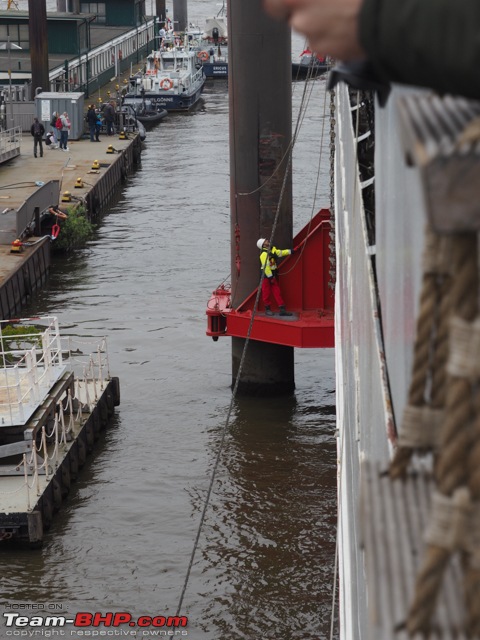 With a bow and stern tug firmly tied up, they use the ships crane to pull out the huge pin.  The bracket is swung open by means of a rope, or more or less by itself as the tugs start pulling. Attachment 2449221 This radio room looks very familiar to me too. I went to see for the first time in the mid 70s. No internet, no mobile network. No nothing. Only these very old radio equipment and a morse-key!! 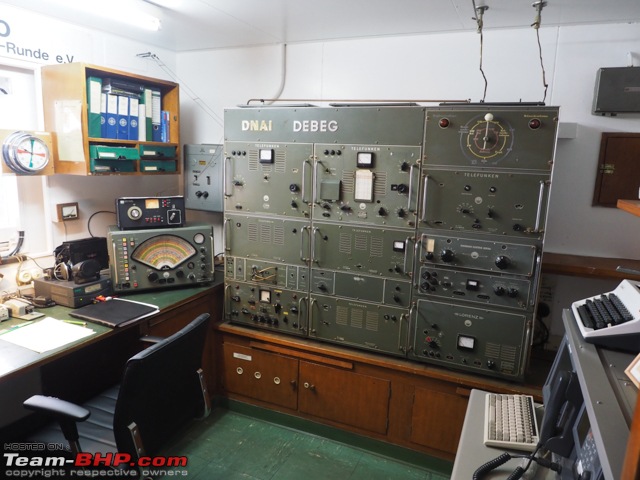  Another interesting feature; The Cap San Diego had a proper pool!! Actually, so did we on the Florida. But ours was all the way on the aft deck. This one is on the main passenger deck.  Some views of the deck and the various cargo holds, cranes, derricks and so on. These general purpose cargo ships had all the facilities to load and unload their cargo by themselves. And when we say General Cargo, it really means anything goes. In my time I have seen just about anything coming onboard, from shoes, sugar, potatoes, various oils, Landrovers, machinery and at one time, even an elephant!!   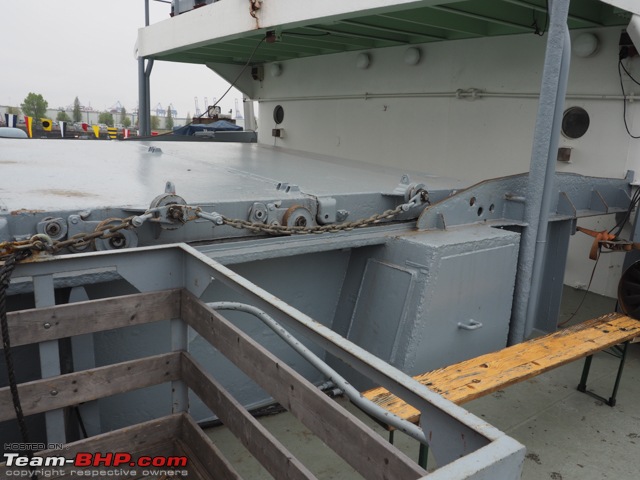 Many ships in those days carried a spare propellor. Just in case! You never know. 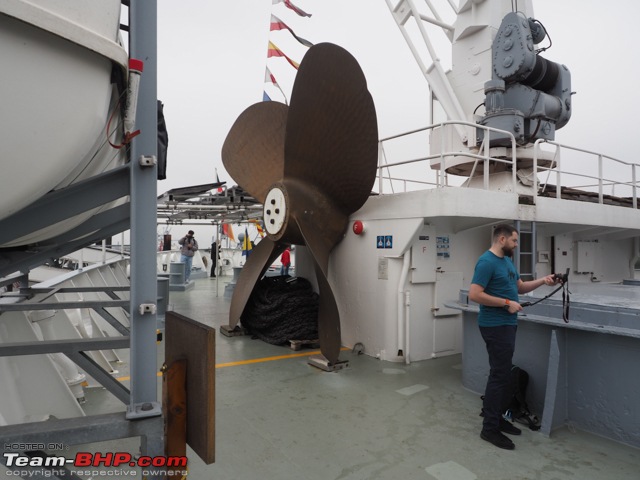 Last edited by Jeroen : 9th May 2023 at 17:21. |
| |  (26)
Thanks (26)
Thanks
 |
| The following 26 BHPians Thank Jeroen for this useful post: | anivy, Aquitej, BlackBeard, Clown Prince, corvus corax, DiMaGo, GTO, libranof1987, matrix1984, Old_Salt, PGNarain, PM - B, raptor_diwan, Reinhard, ryzen7@5800u, sagarpadaki, Samfromindia, sanjayrozario, sarathlal, shashanka, shipnil, Thad E Ginathom, V.Narayan, Venkat_KM, Voodooblaster, ysjoy |
| | #3 |
| Distinguished - BHPian  | Re: Touring the 1961 General Cargo ship Cap San Diego, Hamburg, Germany By 13.00PM we casted off and sailed down the river Elbe. The weather was not all that great. It was pretty grey, overcast with a nasty wind. Never mind, I was enjoying myself immensely and so were all the other guests. And of course the crew. All of the crew are volunteer. There are some 1500 volunteers that work every week on the maintenance of this magnificent ship. Restoring, maintaining and operating this ship is very costly. So they have found all sorts of ways of making money, from sponsor, you can rent it for a business outing, as you might have noticed they also organise “escape room” events. And these sort of tours with guests, means income too. Because it costs about Euro 150 (INR 14000) for this half day tour. 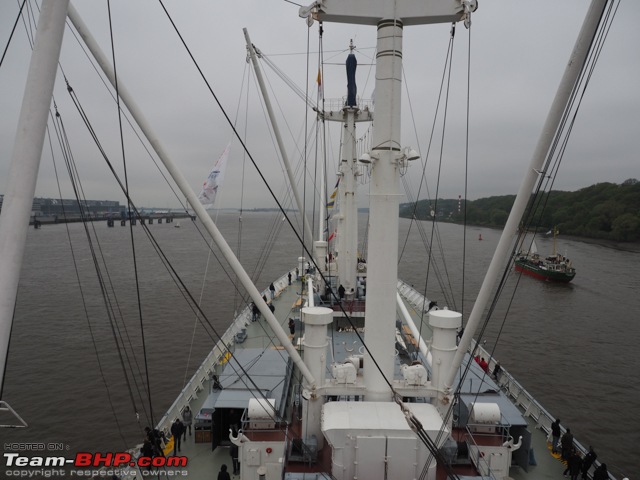 The atmosphere on these museum ships is always great. Everybody is very relaxed, all volunteers love to talk to you about what they are doing. You can go anywhere, see everything, ask any question. There was some good food, and as one would expect on a German boat, lots to drink too! The ships still needs to comply with all normal safety and registration requirements and that goes for the crew as well. So a number of the crew are professional seaman, doing this in their spare time. It got real crowded on the bridge. The middle window it had a little note, please keep free for the navigator. In Germany that is enough to ensure everybody stays back!!  I had noticed a dieselgeneratorset running on the aft deck. Could not figure out what it was for. So when I saw a crew member doing an inspection I asked him why an additional generator?  The answer is actually very simple. I mentioned that the ships generator provide 3 phase 440V 60Hz. But there are convertors that will provide 220V/50hz in the cabins and so. But here is the thing, in the 60s-70s, the need for a lot of 220V/50hz was very limited. I remember the only electrical item I would take with me was a portable cassette/radio! No electrical cameras, phones, iPads, razors or anything like that. But nowadays the world is full of personal gadgets that require lots of 220V. So rather than to upgrade the old convertors, they installed this dedicated 220VAC/60Hz dieselgenset! A few other items that might of interest. An antenna. In fact it is a directional finder antenna. A so called Marconi Direction finder. 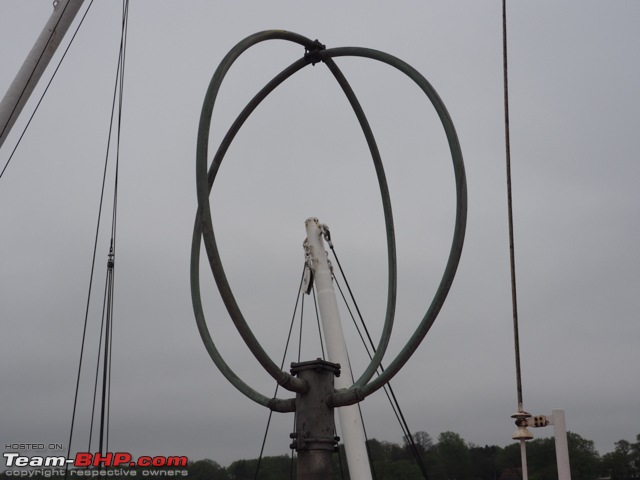 These days, ships have black boxes too. As with airplanes, the black boxes are actually bright orange. I found this one on top of the bridge. Not sure how much it registries, but I guess at least things like position, speed, course etc.  As part of her general cargo capabilities the Cap San Diego could also carry special high quality (expensive) oils. E.g. vegetable oil. They had special holds, that could also be heated. This is the inside of one of these holds and you can see the heating piping arrangement.  As we made our way downriver on the Elbe, we passed a massive Airbus factory. In front of the factory, one of the most unusual looking airplanes ever; the Guppy.  Finally, the anchor winch on the foredeck. All ships have anchor winches and at least two anchors, usually one spare anchor on board too. 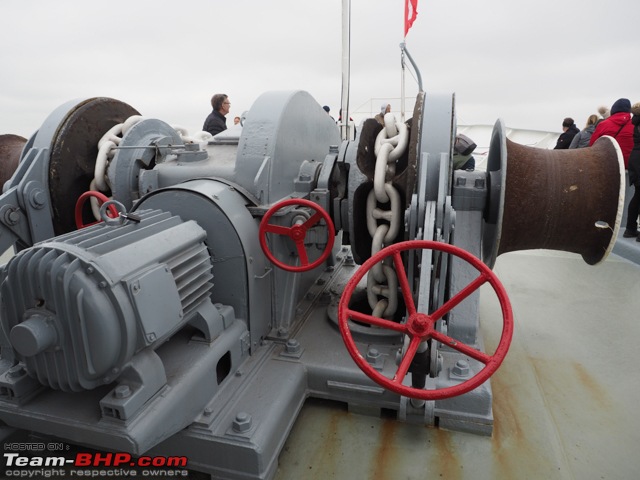 The anchor winch is used to lower the anchor and free fall it. Hence the brakes. And of course to pull it up again. But once anchored the chain is fixed on the so called stopper, releasing tension on the winch. Every so many feet of chain you will find a couple of feet painted white, with in the middle another colour shackle, here you see a red shackle. It is a very simple but very effective system to keep check on how much chain is going out! 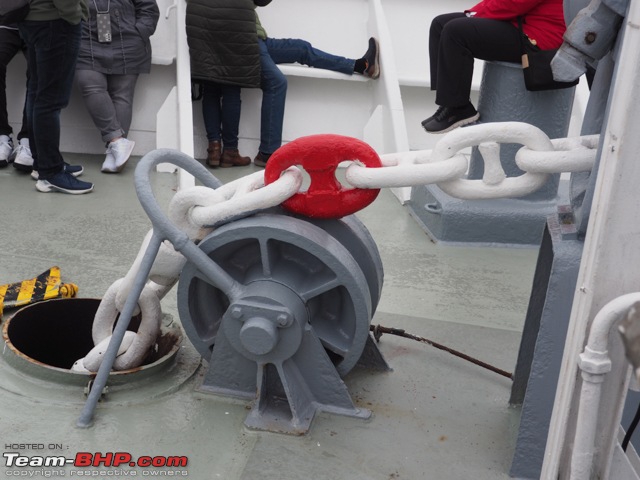 By 1900PM we were once again, moored safely, by means of the two big brackets on the ships hull. All in all a fantastic experience. I had to rush on to my next experience; Miniature Wunderland. Have a look at the website: https://www.miniatur-wunderland.com On Sunday I spend a lot of time in the Maritime museum, which is absolutely fantastic. I also visited a submarine, the U434. I have some photographs as well I might share later. Sunday afternoon is the big farewell parade. Around 16.00 pm all the participating ships cast off and sail up the river, turn around and from 16.30 onwards they sail down the river past the crowds. Tens of thousands of people line up to see this spectacle. By sheer chance I stumbled upon a harbour tour boat at 16.15 that was going along with the parade. I shot some images, just to get flavour what this harbour day event is like. The weather had much improved too! At the head of the parade, this fire fighting vessel, all of its monitors working! 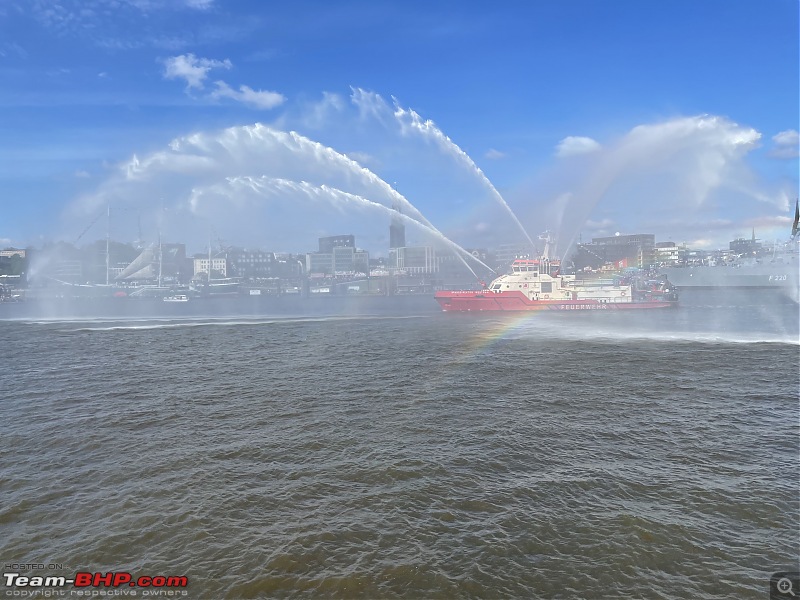 Various tall ships participated.  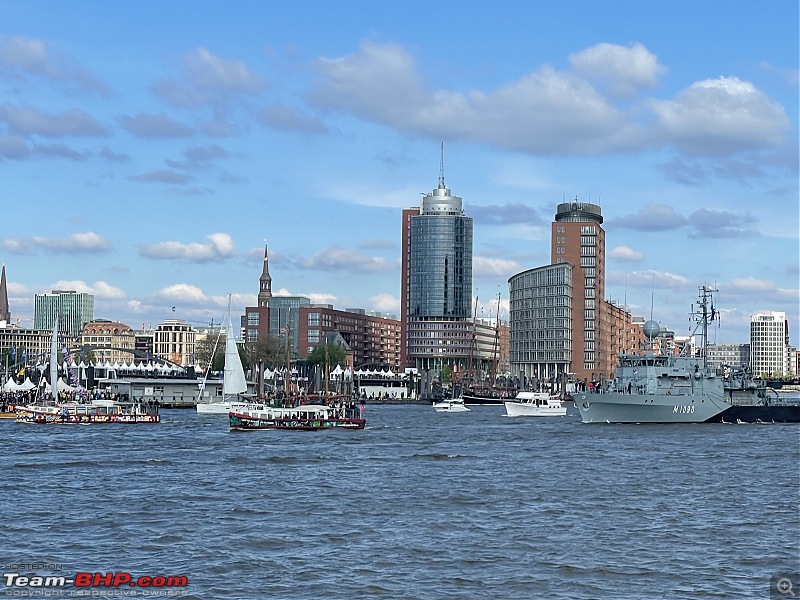 There were a number of war ships participating as well. There were three of these from the Danish Navy.  More tall ships. Look at the number of people on the piers, but also up on the deck half way on that building! 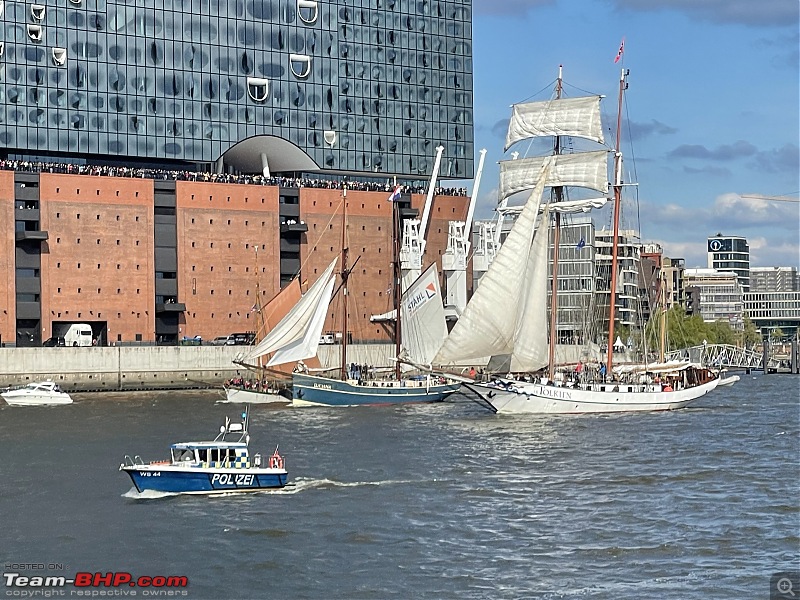 Not only big ships, small ships participate too! she is called Dicke Berta (Fat Berta) Wonder why?  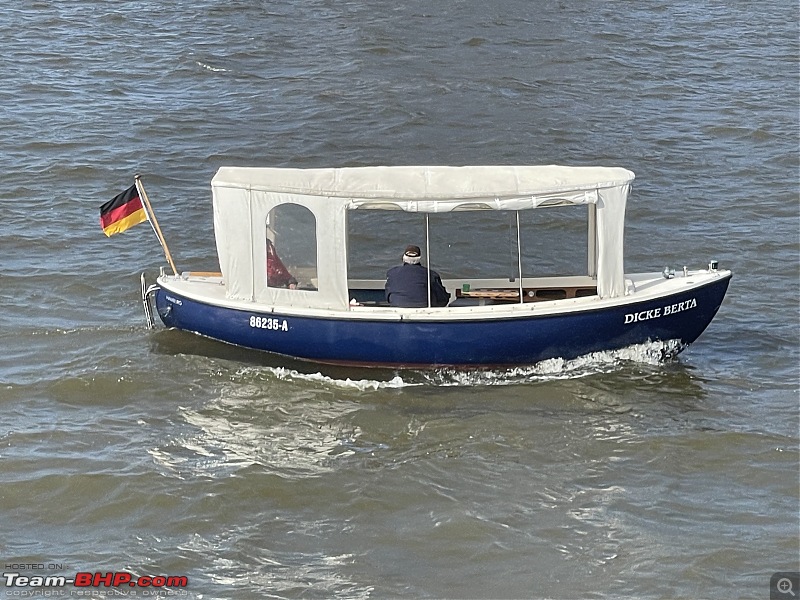 I was immensely pleased to see this, also a museum ship, the Bleichen. She was build in 1958 and is a small bulk carrier. Still need to go and see here too sometime.  There were lots of Dutch sailing vessels participating. 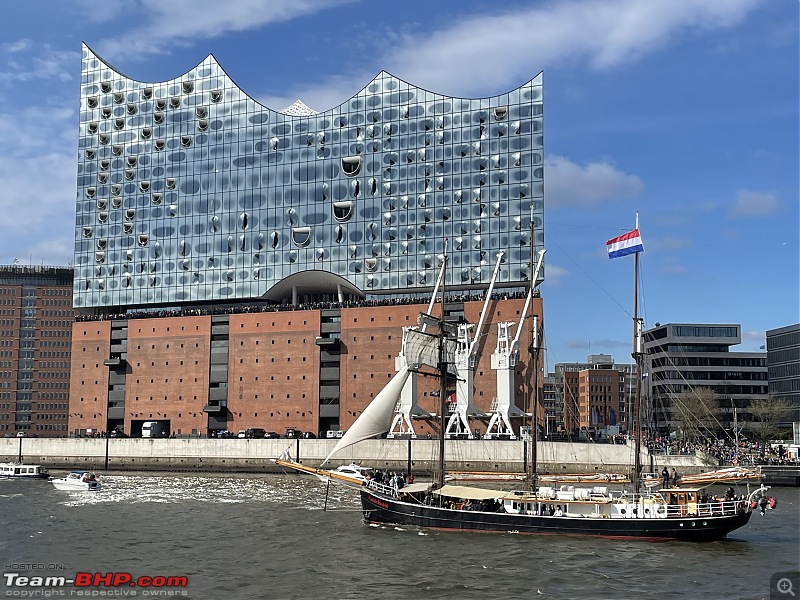 At the background, the German Frigate. On Saturday people were queuing for hours to get onto it. 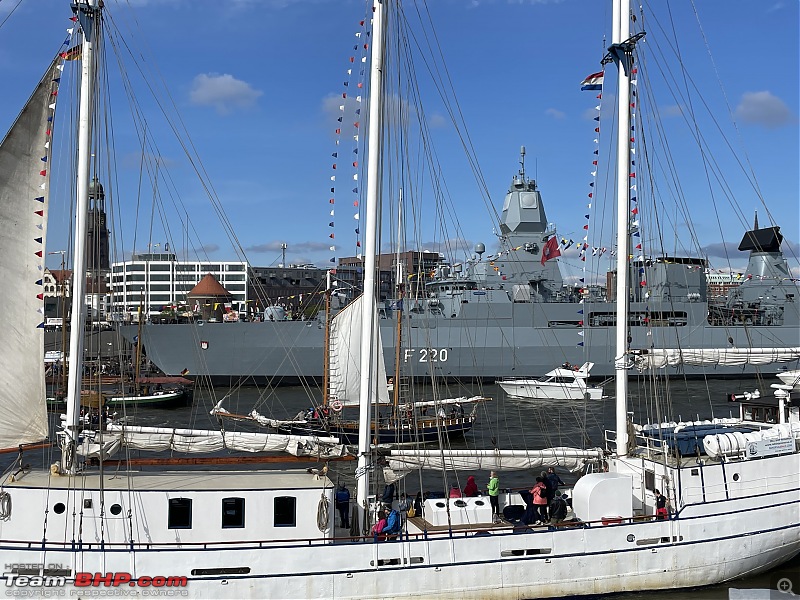 A traditional steam, coal fired, German icebreaker!  I was also very happy to see these two Dutch ocean going tugs. The Elbe and the Holland. 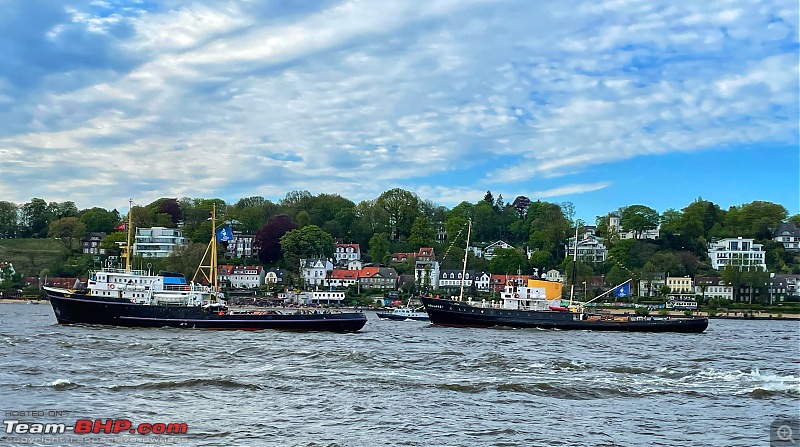 I did a tour on the Elbe some time ago. Read all about it: https://www.team-bhp.com/forum/comme...ml#post5418366 (Returning to my first love | Close look at Ships, Tugs & a Cruiseliner) All in all, a fantastic weekend. Saw lots of different things. The harbour days are an extraordinary event. It is very German with lots of eating and drinking on the streets. There is a 6 kiometer stretch along the water front where the participating ships are moored. All along this 6 kilometer there are things to do, see, various museums, harbour tours, fair etc etc. I end with the same photograph as I started this thread. Gorgeous ship, Cap San Diego  Last edited by Jeroen : 9th May 2023 at 17:22. |
| |  (47)
Thanks (47)
Thanks
 |
| The following 47 BHPians Thank Jeroen for this useful post: | anivy, Aquitej, ashpalio, BhayanaV, BlackBeard, Clown Prince, corvus corax, dexter78, DiMaGo, dragracer567, Gannu_1, GTO, Iyencar, JediKnight, JoshMachine, libranof1987, Lone Ranger, mugen_pinaki27, narmad, NewUser123, Old_Salt, pacman2881, PGNarain, PM - B, ransomware, raptor_diwan, Raul258, Reinhard, Roy.S, ryzen7@5800u, Samfromindia, sanjayrozario, sarathlal, shashanka, shipnil, SlowRider, speedmiester, sukhbirST, texens, Thad E Ginathom, Theyota, UD17, V.Narayan, Venkat_KM, vigsom, Voodooblaster, ysjoy |
| | #4 |
| Team-BHP Support  | Re: Touring the 1961 General Cargo ship - Cap San Diego, Hamburg, Germany Thread moved out from the Assembly Line. Thanks for sharing! |
| |  (2)
Thanks (2)
Thanks
 |
| The following 2 BHPians Thank Aditya for this useful post: | anivy, GTO |
| | #5 |
| Distinguished - BHPian  Join Date: Aug 2014 Location: Delhi-NCR
Posts: 4,071
Thanked: 64,344 Times
| Re: Touring the 1961 General Cargo ship - Cap San Diego, Hamburg, Germany And yet another absolutely marvelous thread by Jeroen which would tickle the hearts of all lovers of ships and the sea. Thank you for this thread and for explaining things in simple non seaman terms. I find ships ever so romantic and fascinating. As a child of course I visited the warships my father served on, on multiple occasions. They were of course different but the romance and fascination is the same. In the late 70s-early 80s a first cousin of mine was a junior navigating officer and whenever his merchant ship docked at Bombay I would spend a night or even two with him! Security was very easy in those days and if the Captain/Chief Officer was a friendly sort it was okay. As a visitor I had to undergo a 1-hour awareness session usually conducted by a junior officer to ensure I didn't do something stupid. Alas, how terrorism has changed the face of such things altogether. The sheer size of those diesel engines never ceases to amaze me even now. |
| |  (10)
Thanks (10)
Thanks
 |
| The following 10 BHPians Thank V.Narayan for this useful post: | anivy, Clown Prince, corvus corax, dragracer567, Jeroen, libranof1987, Old_Salt, PM - B, Reinhard, vigsom |
| | #6 |
| BHPian Join Date: Mar 2017 Location: Delhi
Posts: 153
Thanked: 968 Times
| Re: Touring the 1961 General Cargo ship - Cap San Diego, Hamburg, Germany Thank you Chief! It was good to see the design of Hamburg Sud vessels in the past. Ship designs haven't gone through drastic changes over the years, apart from automation. After Hamburg Sud was sold in 2018, I have had the chance to visit many of them over the last 5 years. Cap San Lazaro, Cap San Vincent to name a few. The german design was quite evident and they still use to carry passengers once in a while. Ofcourse after their sale, this was no longer permitted. |
| |  (5)
Thanks (5)
Thanks
 |
| The following 5 BHPians Thank Old_Salt for this useful post: | BlackBeard, Clown Prince, Jeroen, Reinhard, V.Narayan |
| | #7 |
| BHPian Join Date: Apr 2009 Location: HBX, N. Kar
Posts: 190
Thanked: 917 Times
| Re: Touring the 1961 General Cargo ship - Cap San Diego, Hamburg, Germany That's a beautiful and well looked after ship. I run manufacturing operations for living. In my trade, it is important to have stable manpower. It takes time to build required process knowledge especially when you have highly automated custom built processes and machines. I always wondered how ship owners deal with a changing crew every 3 months. I understand a lot of things are very standardized in shipping, but still I guess there is a lot to learn for me from shipping industry. How they build a sense of ownership in a crew that is on a 3-6 month contract through a 3rd party agency is difficult to imagine. |
| |  (2)
Thanks (2)
Thanks
 |
| The following 2 BHPians Thank Theyota for this useful post: | Jeroen, shashanka |
| | #8 |
| Newbie Join Date: Apr 2022 Location: India
Posts: 22
Thanked: 94 Times
| Re: Touring the 1961 General Cargo ship - Cap San Diego, Hamburg, Germany Thanks for beautiful photographs, Hats off to crew of Cape San Diego for keeping her in such a excellent condition until now. What’s amazing is not how the modern ships have changed but how they are still so much similar to the ones built decades ago. Designs have changed a lot over decades with bulbous bows being used in almost all of present-day fleet of ocean-going vessels. I have always found older ships with straight-stem bows look stunner. I was elated to work on a supertanker with modern design evolved back to straight-stems Last edited by suhaas307 : 11th May 2023 at 01:07. Reason: spacing |
| |  (3)
Thanks (3)
Thanks
 |
| The following 3 BHPians Thank Moto_MP for this useful post: | Jeroen, V.Narayan, Venkat_KM |
 |

